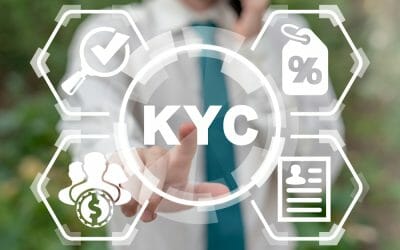What is KYC? Breaking Down the Basics of Know Your Customer
Know Your Customer (KYC) protocols have become an essential part of anti-fraud legislation designed to circumvent money laundering, the funding of illicit activities, protect customer data and provide other levels of heightened security. KYC processes are heavily mandated globally, with each jurisdiction maintaining specific regulations for all relevant businesses and institutions. As criminal activity and risks grow more sophisticated, KYC, AML, and CFT practices must evolve to effectively cover increasingly complex ground and meet the same objectives.
At iComply, we know just how important it is to conduct KYC protocols with data you can trust. Our end-to-end suite of modular iComplyKYC software uses cutting-edge technology backed by industry leaders like Microsoft to provide a seamless compliance experience for both your customers and your team. Below, we’ll take a closer look at some of the fundamentals of KYC protocols and why they matter for your business.
What is KYC?
As the name suggests, the core objective of Know Your Customer mandates is to ensure that organizations are aware of any inherent risks associated with partnering with potential clients, prospective employees, etc. By accumulating the right data, you enable your team to accurately verify the identity of the individual or entity in question, as well as shine a light on any past fraudulent dealings or risk factors that you need to be aware of before moving forward.
When implemented properly, KYC and Customer Due Diligence (CDD) protocols can stop criminals from gaining a foothold and transit point within vulnerable markets and allow you to protect your customers, as well as your reputation from the costly fines and fallout associated with poor practices or non-compliance.
These days, KYC is growing more advanced, with global legislation calling on institutions to implement higher standards and more finessed protocols to tighten their privacy and security and keep fraudulent activity at bay.
The main objectives of a KYC process are:
- Identify and verify the identity of customers (both humans and organizations);
- Properly evaluate the nature and purpose of customer relationships in order to develop customer risk profiles; and
- Continuously monitor, identify, and report suspicious transactions on a risk basis to update client information as needed.
What Elements Are Involved?
In order to achieve the objectives above, KYC utilizes various levels of due diligence and investigation to gather appropriate data, which is used to form a comprehensive risk analysis. While a relatively low-risk client or transaction may only warrant simplified due diligence (confirming name, identity, address, etc), other natural persons or actors may require a closer, more detailed look to get the information you need. The three main levels of due diligence include:
Simplified Due Diligence (SDD)
Simplified due diligence is a faster, more concise entry point for customer due diligence. Where typical due diligence (more on that below) conducts a relatively thorough assessment, SDD is aimed at low-risk clients that present few (if any) red flags and only apply to low-risk products and with no known connections to high-risk jurisdictions and activities. While SDD may sound like it allows customers to skip certain levels of verification, it is typically only implemented with individuals who have already undergone some form of prior assessment that allows you to have a base level of trust. Think, for example, of those utilizing Trusted Traveler programs during travel, allowing them to enter specialized, fast-tracked lanes at airport security.
Customer Due Diligence (CDD)
For those who don’t have an existing profile or proven track record, standard due diligence takes a much closer look at identification verification, known associations, ties to fraudulent/criminal activities, exposure vulnerabilities, and other pieces of data that flesh out a fairly comprehensive risk profile. Once a client is able to verify that they are who they say they are and fit within your risk quotient/present no legal conflict, you can proceed with confidence.
Enhanced Due Diligence
Sometimes, a standard data set isn’t enough to make an accurate assessment of someone’s risk, especially if you’re dealing with high-profile clients like Politically Exposed Persons (PEP), high-value transactions, or those operating in jurisdictions with a previously identified risk for fraudulent activities. In these cases, Enhanced Due Diligence (EDD) searches for even deeper, more specific information that provides an in-depth look at the individual, their close contacts, any adverse media that may be associated with them, and the like. EDD is an essential and irreplaceable part of fraud prevention—and should be a top priority of any organization wishing to stay compliant with KYC, AML, and CFT legislation.
Staying on Top of Legislation
Today’s world moves quickly, and in order to keep up with evolving KYC and AML regulations, relying on manual due diligence practices simply isn’t a viable reality for most organizations.
Partnering with a proven KYC platform such as iComplyKYC’s turnkey suite of digital tools helps keep your security processes in alignment with all relevant legislation and ensures you are as protected as possible. From standard CDD to enhanced due diligence, continuous monitoring, and beyond, iComply is proud to offer you a truly end-to-end KYC compliance experience designed with your needs in mind.
Book a demo with our team today to learn more about our platform, as well as how you can streamline your anti-fraud processes with iComplyKYC.
learn more
Is your AML compliance too expensive, time-consuming, or ineffective?
iComply enables financial services providers to reduce costs, risk, and complexity and improve staff capacity, effectiveness, and customer experience.
Request a demo today.
How to Spot Fraudulent Users with KYC Protocols
While we often speak about the many risks and crimes that Know Your Customer (KYC) protocols help to circumvent (the reactive approach), the cybersecurity industry can sometimes forget to highlight the specific ways KYC software and practices offer protection (the...
Eye On Compliance in 2023: Top KYC Trends
As Q2 of 2023 ramps up, the compliance industry continues to face a fast-paced environment of global changes and challenges when implementing protective measures against fraud, money laundering (AML), and other forms of financial crime (FinCrime). 2022 brought no...
Digital Identities in 2023: Trends and Updates
With the first months of 2023 already showing uncertainty in both financial and digital markets (re: Silicon Valley Bank and Credit Suisse), business leaders are looking for ways to stay on top of evolving trends and patterns of risks to mitigate the harm caused by...



